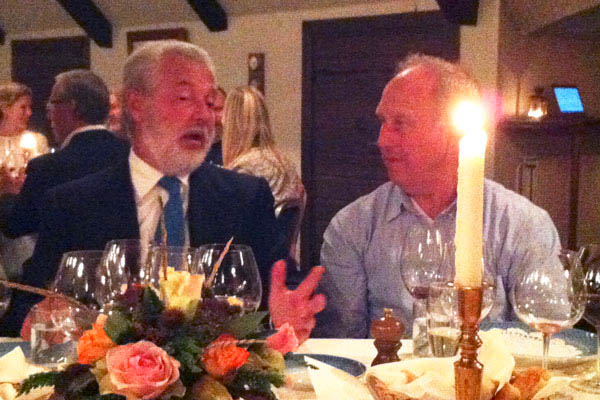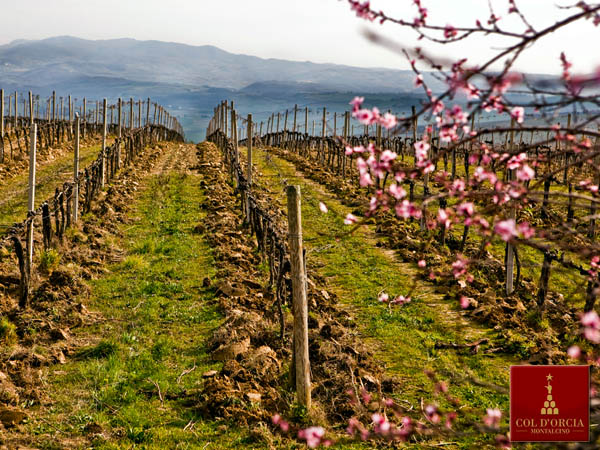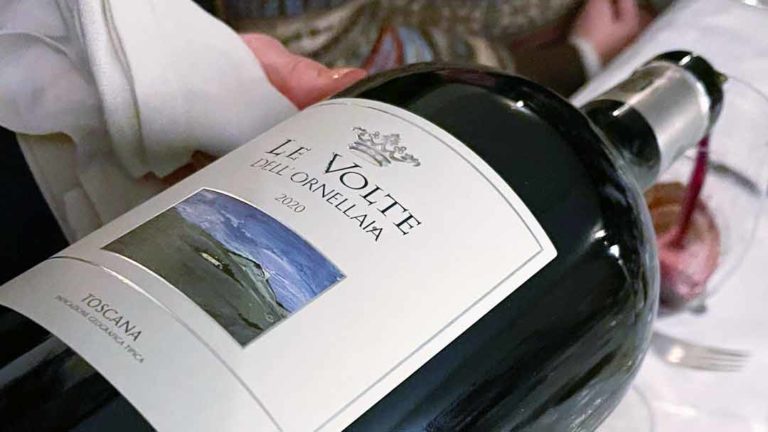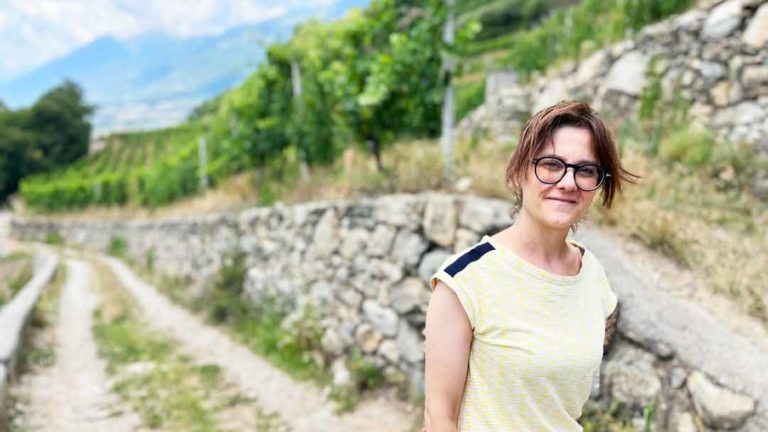Horizontal and vertical of Brunello di Montalcino with Count Cinzano
Tenuta Col d’Orcia is one of the best known producers of brunello di Montalcino in Tuscany. They make several different wines, mainly red wines from the brunello clone of the sangiovese grape. Francesco Marone Cinzano is at the helm of the Col d’Orica winery. When count Cinzano came to Sweden, bringing with him a Tuscan chef, BKWine Magazine sat down with him for a chat and an extensive tasting over a Tuscan dinner. It was both vertical, back to 1968, and horizontal. BKWine’s Carl-Erik Kanne reports.
Count Francesco Marone Cinzano had brought his own chef when he came to Stockholm. He also brought his own wines. He owns the prestigious Tuscan winery Col d’Orcia. Food and wine from Italy, from Montalcino, is hard to say no to so I had accepted the count’s invitation for a tasting and lunch.

The chef came from the restaurant Il Silene in Montalcino. He gave us a real winemaker’s lunch with food and wines from the region. Brunello di Montalcino. All ingredients, except the vegetables, had also been brought from Italy specifically for the purpose.
The count began by giving a very brief background to the region of Montalcino where he particularly wanted to emphasize the great variation between different winemakers; about 290 different wineries over 3,500 hectares of vineyards. The various positions and relation to sea breezes and the hilly countryside are the major influence on the wines giving a micro-climate that is varied. You really get the impression that terroir makes a difference. Col d’Orcia is situated in the south-west corner of Montalcino with great influence from the sea breezes.
Regarding Col d’Orcia’s focus, he stressed that they want to be regarded primarily as a brunello specialist although they also produce other wines. An important part of the business is to provide a very wide range of old vintages from the cellar (30,000 bottles from the 60s and onwards).
He sees the work in the vineyard and in the cellar as a teamwork that as far as possible is made by hand, from planting and pruning to thinning of leaves, green harvesting and bunch selection when picking the grapes. The motto “wines are made in the vineyard” is an expression of how they look at the winemaking.

Great emphasis is also placed on the environment and all the are since 2013 are classified as “fully organic”.
In the wine cellar work is carried out using traditional methods for the area which among other things means that the ageing of wines is mainly done in very large wooden casks, 2500 l, 7500 l and 15,000 l. This also means that the wines normally take time to mature and vintage variations are notable.
Brunello di Montalcino, vertically
While the Count told me about his winemaking the waiters had poured 8 wines.
Time to start gently with the youngest brunello, Col d’Orica Brunello di Montalcino 2007 (~28 euro; all price indications are based on current prices in Sweden). The colour was bright red, and with an aroma of cherries. In the mouth it had good acidity, very fresh fruit, moderate tannins and a long finish. It was clear that the wine was young, but had a lightness and elegance that were promising for the future.
Next glass contained the Col d’Orica Brunello di Montalcino 2006, which was darker red and had a scent with cherry and plum, a denser fruit, significantly more tannins, but good texture and chewiness. A more mature wine that will become even better. It got many appreciative comments from the tasters.

The third wine, Col d’Orica Brunello di Montalcino 2005, came from a somewhat lesser vintage but had a nice balance of acidity and fruit and a little youngish finish. Will gain from a few more years in the cellar.
The fourth glass, the Col d’Orica Brunello di Montalcino 2004, had dark colour and aromas of cherry / violet. In the mouth, it was a rough wine that needs time in the cellar, but with great potential with lots of flavours and long after-taste.
Glass number 5, Col d’Orica Brunello di Montalcino 2001, also received many appreciative comments. Here there was a dark, brownish-red colour, complex aroma, good acidity and concentrated fruit in the taste, sandy tannins and a long finish.
Expectations escalated now facing glass number 6, Col d’Orica Brunello di Montalcino 1995, and it did not disappoint! The wine was high up on the maturity curve, but did not feel as if it had passed its peak yet. Complex aromas and a flavour that begins to reveal many good secrets. A well-balanced and very good wine now.
When glass number 7 arrived, Col d’Orica Brunello di Montalcino 1985, the happy expressions changed! The colour was brown, and the smell already revealed that the wine was on the road down the hill. Flavour of raisins / figs revealed some oxidation.
Finally glass number 8, Col d’Orica Brunello di Montalcino 1968, was an amazing experience, especially in contrast to the number 7, and evidence that good vintages, properly treated have a very long life! Here we were met by a brownish-red colour, but the nose was one of fresh fruit, and the taste had a good acidity and pure fruit and soft tannins. Long after-taste. A terrific wine whose flavour is said to recall the “roast nuts”.
Interesting is also the youthfulness that this wine was able to show despite that the vintage just qualified as three star (see below).
In summary, this gave me a new dimension of Tuscany whose Brunello wines in Sweden has had less attention than others in the region. The wines are aged in large oak barrels so they do not have any intrusive oakiness, but the oak gives a good round-off of the character, but it takes time.
Most of these wines are very good cellaring wines with long ageing potential. The young are comparatively affordable today.
Some of the tested wines are available to order from the importer (Carovin), and number 1 is even available both in the half bottle and full bottle at Systembolaget (the retail monopoly). Indicative prices: vintage 2006 for about 29 euro, vintage 1995 for about 80 euro, and the year 1968 for about 250 euro.
DOCG Brunello di Montalcino, with its siblings
The Montalcino region can be described as a square area of land around Montalcino hill some 40 km south of Siena and delimited by the rivers Ombrone, Asso and Orcia.
The climate is Mediterranean, but with elements of continental effects due to location between the sea (about 40 km) and the Apennines (about 100 km). Annual precipitation is about 700 mm, and it falls essentially in spring and late fall. Snow can occur at altitudes above 450 m. Mount Amiata in the South Shields Montalcino from rain and hail storms.
The conditions are ideal in other words for cultivating wine and to obtain both progressive and full maturity of the grapes.
The soil varies with loose soil layers at the bottom of the valleys and firmer bedrock higher up mostly consisting of marl and limestone. Although wine is produced in the area since long back, it is worth noting a few events along the road.
In connection with the unification of Italy in the 1860s, Ferruccio Biondi-Santi took over his grandfather’s vineyard Fattoria del Greppo and began to apply for the region new technologies, which would eventually form the school here. The first bottle of Brunello made exclusively from a clone of sangiovese grosso, called brunello, was bottled in 1888.
The main difference from before was that he vinified the different varieties separately. Earlier they had vinified all together (cf. gemischte satz in Germany). The result was that the wines had much cleaner fruit in aroma and flavour.
For a long time the family Biondi-Santis was one of the few producers who made brunello, but after the 2nd World War, things started to happen, and producers of brunello increased year by year.
1968 DOC rules were established and in 1980 the current DOCG status was obtained, moste recently modified in 1998. In connection with the establishment of the DOC the Consorzio del Vino Brunello di Montalcino was formed in 1967, as a free association of winemakers to protect the wine and emphasize its qualities.
As in France the DOC / DOCG rules regulate a number of variables relevant to the wine’s characteristics, such as the maximum harvest yields, the grape varieties to use, which bottle sizes they can be sold in, when the wine at the earliest may be sold in relation to the harvest year, and how long the wine has to be aged in wooden barrels and / or bottle before sale.
The newly produced wine in Montalcino is classified annually in January by the Consortium. This is true for brunello di montalcino, rosso di montalcino, moscadello di montalcino and sant’antimo.
The evaluation results in a number of stars awarded to wines from * (one star) to denote unsatisfactory to ***** (five stars) denoting exceptional vintage. From 1992, an artistically designed tile is created to illustrate the current vintage.
For the tasted vintages of Col d’Orcia these were the ratings:
- 1968 = ***
- 1985 = *****
- 1995 = *****
- 2001 = ****
- 2004 = *****
- 2005 = ****
- 2006 = *****
- 2007 = *****
The organisation has recently created an on-line tool for verification of the authenticity of a brunello wine.
By entering the alphanumeric code found on the neck label, consumers will access all the producer information entered and which may be of benefit to the customer. The system works from vintage 1999 for brunello di montalcino and from vintage 2005 for rosso di montalcino.
Brunello and siblings matched with Tuscan food
After the tasting, it was time to stretch one’s legs and move toward the beautiful dining room upstairs. To refresh one’s mouth a Champagne was served with fine acidity.
When everyone had sat down the chef Roberto Rossi from Ristorante Il Silene in Motalcino was introduced. He often accompanies the Count at winemaker’s dinners both at home and abroad.
The menu was impressively long with 8 dishes plus finishing small pastries and olive oil-filled chocolates. The dishes were composed partly to give an expression of the local food culture in Montalcino and partly to in a good way accompany the range of wines that the Count had chosen to present.
As an amuse-bouche was served a panzanella (Tuscan bread salad) accompanied by bread and olive oil which formed a nice backdrop to the first wine Col d’Orcia Pinot Grigio Sant’Antimo 2013 (~16 euro). The wine had pears on the nose, was fresh and flavourful with a little fruit sweetness in the taste despite a residual sugar of only 3 g/l. Relatively long finish. Nice white food wine and unusual with a pinot gris from Tuscany. The rather lively acidity in wine can possibly be traced to that only a portion of the wine had undergone malolactic fermentation.

The next dish was a wonderful steak tartare chopped by hand and served with crispy vegetables. The accompaniment in the form of Rosso di Montalcino 2011 (~14 euro) worked flawlessly with its fresh acidity and clean fruit. The wine is mainly aged in large Slovenian oak casks after a controlled fermentation in stainless steel tanks.

Hereafter arrived a little pasta dish, tortelli, with old-aged parmesan and Col d’Orcia’s olive oil. A delicious dish served with what was called a mini-brunello, Banditella Rosso di Montalcino 2010 (~25 euro). A very good choice. The wine can be said to give a taste of what a Brunello from 2010 will be, and it bodes well! A lot of wine for one’s money.
After gentle extraction of flavor and color in specially designed stainless steel tanks, the wine is stored for more than 12 months in new French oak barrels where malolactic fermentation also occurred.
As it should be in a better Italian cuisine the menu included a risotto, here deliciously flavoured by beef marrow and white truffles. To this had been chosen one of the previously tasted wines, Brunello di Montalcino 2006, now served from magnum bottles. (~60 euro).
The combination emphasized that brunello wines are food wines first and foremost. The wine is aged in barrel for 4 years, including 3 years in large oak barrels (5000-7500 l), followed by 6 months bottle aging.
A first main course consisted of roasted whole pork mini chops, cinta senese, a small vegetable flan and mushrooms. The wine for this was a real thoroughbred in the form of Poggio al Vento Bunello di Montalcino 2006 (~75 euro). The grapes for this wine come from old vines from a particularly good location. Well balanced and tasty wine with a long finish.

Fermentation for 25 days with temperature control with daily batonnage in the morning and pumping over in the evening. Ageing four years in oak barrels from Slavonia and from France and 24 month temperature regulated bottle aging.
Remained now the second main course which was wild boar in chocolate which was served with a cabernet sauvignon named Olmaia Sant’Antimo Cabernet 2010 (~44 eur). An unusual dish for us Swedes and an elegant and generous wine with great cabernet typicity and long finish.

Like the previous wine it had fermented in stainless steel tanks with temperature control for 20 days and also with daily batonnage. Subsequently ageing for 18 months in new small French oak barrels, followed by bottle ageing for one year.
The dessert was a millefeuille cake with fresh berries matched with a natural sweet wine, Pascena Moscadello di Montalcino Vendemmia Tardive 2010. (not available in Sweden)

Interesting we were told that this type of wine is the oldest in Montalcino, for long before the brunello arrived they made good muscadello wines. This wine was a delicious companion to the cake with a nice balance of acidity and soft sweetness with flavours of apricot and peach.
An olive oil-filled chocolate praline finished the meal. A very rewarding evening in good company.
The tasting and the dinner was organised by Carovin / Oenoforos, Col d’Orica’s importer in the Sjöfartshuset on the Skeppsbron in Stockholm under the supervision of Lisa Lind and Flavia Bergström.
Carl-Erik Kanne is a long time wine enthusiast and fervent wine taster. He reports from wine tastings and wine events in Stockholm for BKWine Magazine.
[box type=”info” style=”rounded” border=”full”]
Montalcino is a beautiful area to visit in Tuscany. If you want to truly experience its gastronomy and the brunello di montalcino wines you can join a wine tour to Tuscany with BKWine.
Travel to the world’s wine regions with experts on wine and the wine tour specialist.
Wine of a kind that no one else can do.
[/box]








